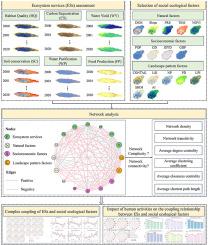生态系统服务与社会生态因子复杂耦合关系的动态变化及人类活动影响:来自网络分析的见解
IF 5.4
2区 地球科学
Q1 GEOGRAPHY
引用次数: 0
摘要
了解生态系统服务(ESs)与社会生态因子(SEF)之间的耦合关系对生态系统的可持续性具有重要意义。然而,大多数早期的研究都集中在SEF对ESs的单独影响上,而没有深入研究它们的耦合动态、趋势和人类活动的作用。为了弥补这一空白,我们分析了2000 - 2020年海南岛生态环境的时空变化,包括粮食生产(FP)、土壤保持(SC)、水量(WY)、碳固存(CS)、水净化(WP)和生境质量(HQ)。采用网络分析和广义加性模型研究了ESs和SEF的耦合关系和趋势。我们还评估了这种耦合关系在不同人类活动强度下的变化。结果表明,HQ、WP、CS在研究期间的变化相对较小,而SC、WY、FP的波动较大。随着时间的推移,ESs和SEF的耦合关系逐渐减弱,网络复杂性和连通性下降。HQ、CS、归一化植被指数和景观格局因子对网络连通性和复杂性的正向贡献逐渐减弱。而建设用地占比、国内生产总值占比、耕地占比等SEF负贡献逐渐增大。随着人类活动强度的增加,网络连通性和复杂性呈下降趋势。该研究不仅为理解生态环境与海洋生态环境之间的复杂关系提供了新的视角,也为海南未来的生态保护政策提供了理论支持。本文章由计算机程序翻译,如有差异,请以英文原文为准。

Dynamic changes of the complex coupling relationships between ecosystem services and socio-ecological factors and the impact of human activities: Insights from network analysis
Understanding the coupling relationships linking ecosystem services (ESs) and socio-ecological factors (SEF) is important to the sustainability of ecosystems. However, the majority of earlier research concentrated on the separate effects of SEF on ESs, without thoroughly investigating their coupling dynamics, trends, and the role of human activities. To address this gap, we analyzed the spatiotemporal variation of the ESs on Hainan Island from 2000 to 2020, including food production (FP), soil conservation (SC), water yield (WY), carbon sequestration (CS), water purification (WP), and habitat quality (HQ). Network analysis and the generalized additive model were used to investigate the coupling relationships and trends linking ESs and SEF. We also evaluated the variations of this coupling relationship under different human activity intensities. The results showed that HQ, WP, and CS exhibited relatively small changes during the study period, whereas SC, WY, and FP showed greater fluctuations. The coupling relationships linking ESs and SEF gradually weakened over time, with network complexity and connectivity declining. The positive contributions of HQ, CS, normalized difference vegetation index, and landscape pattern factors to network connectivity and complexity gradually diminished. In contrast, the negative contributions of SEF, including the percentage of construction land, gross domestic product, and percentage of cultivated land gradually increased. As human activity intensity increased, network connectivity and complexity showed a declining trend. This study not only offers new insights into comprehending the complex relationships linking ESs and SEF, but also provides theoretical support for future ecological protection policies on Hainan Island.
求助全文
通过发布文献求助,成功后即可免费获取论文全文。
去求助
来源期刊

Applied Geography
GEOGRAPHY-
CiteScore
8.00
自引率
2.00%
发文量
134
期刊介绍:
Applied Geography is a journal devoted to the publication of research which utilizes geographic approaches (human, physical, nature-society and GIScience) to resolve human problems that have a spatial dimension. These problems may be related to the assessment, management and allocation of the world physical and/or human resources. The underlying rationale of the journal is that only through a clear understanding of the relevant societal, physical, and coupled natural-humans systems can we resolve such problems. Papers are invited on any theme involving the application of geographical theory and methodology in the resolution of human problems.
 求助内容:
求助内容: 应助结果提醒方式:
应助结果提醒方式:


